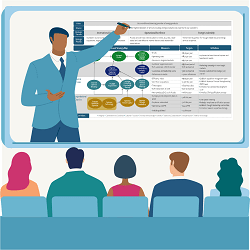 After months of hard work, we finally made it to the rollout event – my first. In an all-hands meeting, we detailed the plan, bragged about increased focus, increased alignment, improved team cohesion, and the 40+ new projects resulting in new and improved services or products over the next several years. We were expecting a warm reception.
After months of hard work, we finally made it to the rollout event – my first. In an all-hands meeting, we detailed the plan, bragged about increased focus, increased alignment, improved team cohesion, and the 40+ new projects resulting in new and improved services or products over the next several years. We were expecting a warm reception.
The reception we got, however, was not warm at all. “It’s too much work”, was one complaint, while others questioned everything: “How will we get all of this done?”, “Who will do all of this work?”, and “Why don’t our leaders prioritize?”
Why don’t we prioritize? We had a strategic plan. We had gathered staff input then identified key areas to focus on. And we had identified hundreds of potential critical strategic projects and prioritized them down to the critical few. Wasn’t that all prioritizing? While the answer to those questions might have been yes, it was not enough.
Our Rollout Communication Did Not Address Capacity
While it is critical for leadership to communicate the strategic plan at rollout, they must also understand and communicate how the enterprise’s capacity (volume of work the enterprise can handle) impacts the execution of the strategic plan.
The strategic planning process generates new projects that, in theory, get the enterprise from where it is to where it wants to be. If the leadership team does not understand their enterprise’s capacity and simply adds projects to an already overworked staff, the enterprise project portfolio and success of those working on the projects are at risk of failure. Further, if leaders do not understand the enterprise’s capacity, they will have a difficult time convincing staff to charge up the strategic hill with them. The unfortunate reality is that many strategic plans begin their downward spiral out of the gate in this way.
Discussing Employee Capacity During Planning, Rollout, and Beyond
Capacity planning takes practice and requires a culture change at the highest level. Most organizations lack a formal capacity planning competency; however, it is possible to introduce capacity discussions into the strategic planning process to encourage self-evaluation and transparent conversations.
Most employees are open to new strategic projects when leaders openly discuss the difficult topics of capacity and work-life balance. This does not mean leaders should promise to resolve capacity issues overnight, but rather, they must demonstrate an understanding of what is happening on the ground and how their decisions impact staff’s lives – then act on it.
Some of the best leaders I have worked with spoke with their staff regularly about ways to improve strategy execution and acknowledged that to do so required a focus on a few things versus many. More importantly, they created processes to support this philosophy which increased the chances of success.
The key is getting leadership to go from where they are today, to understanding their capacity, to then managing based on that capacity.
You can learn more about strategic planning and performance management by visiting our website and downloading various thought leadership articles, blogs, and webinars.
Richard Juarez, MBA, BSMP, PMP, KPIP, rjuarez@strategymanage.com, is a Senior Consultant, Strategic Planning and Strategy Execution for the Balanced Scorecard Institute/Strategy Management Group. Richard is a performance management expert and thought leader who brings real-world planning and execution experience to his training and consulting engagements. Richard is also a secondary author/reviewer on A Guide to the Business Architecture Body of Knowledge® (BIZBOK® Guide), v 5.1; 2016.


